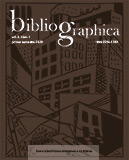Abstract
The Breviarios is one of the Fondo de Cultura Económica’s [Economic Culture Fund] most prominent and successful collections. Without a doubt, the physical and intellectual quality of each volume in the series completely transformed the publishing industry in Latin America. In order to better understand the impact and origins – both aesthetic and educational – of the collection itself, I will examine a series of its global precursors. In particular, I will analyze various international collections since the first half of the 20th Century, from those of Albatross Press and Penguin Books to those of Emecé Editores, for their form and content. In addition, I will compare and contrast the publishing strategies and artistic aims of these precursors in an effort to stress the originality of the Breviarios.
Authors who publish in Bibliographica automatically accept the following terms:
a. Authors will keep their authorship rights and will guarantee the journal the first time publication rights of their submitted work, which will be liable to a Creative Commons license that will allow third parties to share their work as long as they give appropriate credit to the author and the first publication is attributed to Bibliographica, it is not used for commercial purposes and modified material is not distributed in case of remix, transformation or recreation.
b. Authors can adopt other non-exclusive distribution license agreements of the published version of the work (for example: deposit it in an institutional telematic archive or publish it in a monographic volume) as long as the first publication is attributed to Bibliographica.
c. Authors are encouraged to self-archive their work (for example: in institutional telematic archives or their website), for this can promote interesting exchanges and increase the citation impact of the published work. (See The effect of open access).
